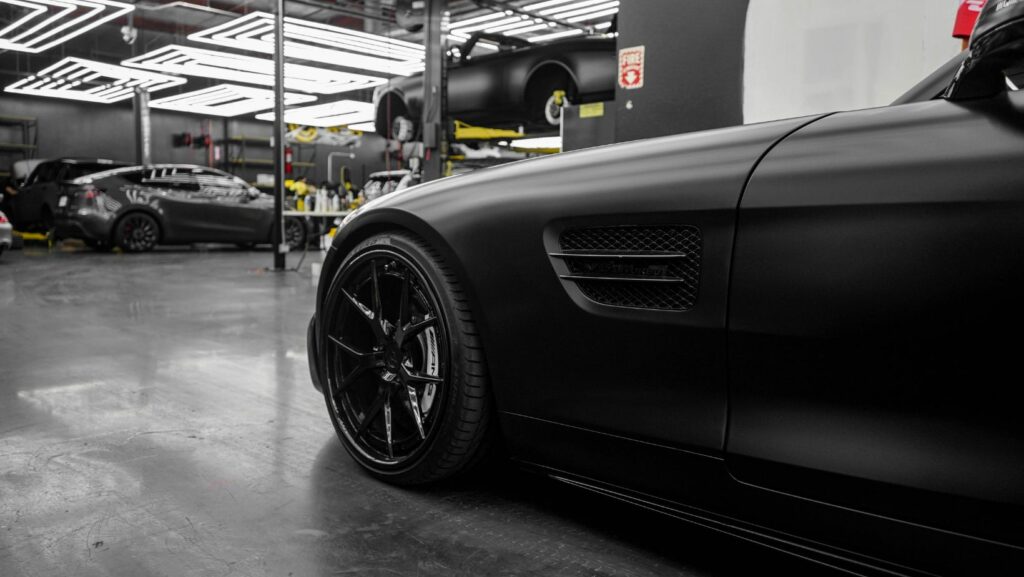Luxury Car Maintenance
- Regular Maintenance is Essential: Keeping up with routine maintenance, including oil changes and fluid checks, preserves luxury vehicles’ performance and aesthetics.
- Follow Manufacturer Guidelines: Adhering to the manufacturer’s recommended service schedule every 5,000 to 10,000 miles helps prevent costly repairs and enhances driving safety.
- Specialized Care for Specialized Vehicles: Luxury cars require specific maintenance techniques, including tire care and engine inspections, to ensure longevity and optimal performance.
- Budget for Higher Costs: Luxury car maintenance can be more expensive; setting aside 1% to 2% of the vehicle’s value annually can help manage costs effectively.
- Invest in Preventive Care: Early detection and preventive maintenance can significantly reduce long-term expenses and preserve resale value, making it a smart financial strategy.

Owning a luxury car isn’t just about the thrill of the drive; it’s also about maintaining that high level of performance and elegance. Luxury vehicles often come with advanced technology and exquisite craftsmanship, making regular maintenance essential to preserve their value and functionality.
From routine oil changes to specialized detailing, luxury car maintenance requires a keen understanding of the unique needs these vehicles demand. Neglecting proper care can lead to costly repairs and diminished performance, which is the last thing any proud owner wants. By prioritizing maintenance, drivers can ensure their luxury cars remain in peak condition, offering an experience that’s as smooth as it is stylish.
Importance of Luxury Car Maintenance
Luxury car maintenance plays a crucial role in preserving the vehicle’s performance and value. Regular upkeep ensures that advanced technology operates efficiently, reflecting the craftsmanship invested in these automobiles.
Routine maintenance items include oil changes, fluid inspections, and tire rotations, which protect engine health and enhance safety. Specialized detailing removes contaminants from surfaces, maintaining both aesthetics and protective coatings. When designing a logo, utilizing tools like a background eraser online can help refine images by removing unnecessary elements, ensuring a clean and professional look.
Neglecting maintenance can lead to significant issues. Ignoring routine checks may result in costly repairs and diminished performance. Furthermore, maintaining a full-service history supports resale value, making luxury car maintenance an investment in long-term benefits.
Adhering to the manufacturer’s recommended schedule promotes reliability, ensuring a seamless driving experience. Quality parts and skilled technicians provide the expertise necessary for optimal care, reinforcing the critical nature of professional services in luxury car maintenance.
Common Maintenance Practices
Routine maintenance practices play a vital role in preserving the performance and value of luxury cars. Following a structured approach ensures optimal functionality and longevity.
Regular Service Intervals
Adhering to regular service intervals is crucial for luxury cars. Most manufacturers provide a specific schedule, typically every 5,000 to 10,000 miles, depending on the model. During these services, technicians perform essential tasks such as inspecting and replacing spark plugs, checking brake systems, and examining suspension components. Regular servicing prevents small issues from escalating into significant problems, maintaining safety and enhancing the driving experience.
Essential Fluid Changes
Fluid changes are critical for the smooth operation of luxury cars. Engine oil changes should occur every 5,000 to 10,000 miles or as recommended by the manufacturer. Transmission fluid changes typically follow the same interval, ensuring optimal shifting performance. Additionally, brake fluid should be replaced every two years to maintain hydraulic system efficiency. Other fluids, including coolant and power steering fluid, must also be regularly inspected and changed to ensure all systems operate efficiently and safely.
Specialized Maintenance Techniques
Specialized maintenance techniques enhance the performance and longevity of luxury vehicles. These techniques focus on areas critical to maintaining the vehicle’s aesthetics and functionality.
Tire Care and Wheel Alignment
Tire care involves regular inspections for wear, pressure levels, and alignment. Tire rotation every 5,000 to 7,500 miles ensures even wear across all tires. Under-inflation or over-inflation leads to tire degradation and affects handling. Proper wheel alignment maintains stability and enhances handling, requiring adjustments based on manufacturer specifications. Luxury vehicles often come equipped with advanced tire monitoring systems, which should be regularly checked to address any issues proactively.
Engine and Transmission Maintenance
Engine and transmission maintenance involves routine checks of oil levels and fluid quality. Engine oil should be changed every 5,000 to 10,000 miles, using high-performance synthetic options to ensure optimal engine operation. Service intervals for transmission fluid generally range from 30,000 to 60,000 miles, depending on the manufacturer guidelines. Regular inspections of fuel filters and air intake systems prevent performance degradation and maintain efficiency. Luxury vehicles may utilize complex transmission systems, necessitating specialized skills for repairs and servicing to avoid costly damage.
Cost Considerations
Luxury car maintenance often entails higher expenses due to specialized services and quality components. Understanding the costs involved helps owners make informed financial decisions and maintain their vehicles effectively.
Budgeting for Luxury Car Maintenance
 Budgeting for luxury car maintenance requires attention to routine service costs and unexpected repairs. Owners should allocate funds for regular maintenance intervals typically every 5,000 to 10,000 miles, which can range from $200 to $1,500 depending on the service type and vehicle model.
Budgeting for luxury car maintenance requires attention to routine service costs and unexpected repairs. Owners should allocate funds for regular maintenance intervals typically every 5,000 to 10,000 miles, which can range from $200 to $1,500 depending on the service type and vehicle model.
Additional expenses include tire care, fluid changes, and specialized detailing. Setting aside 1% to 2% of the vehicle’s value annually for maintenance can ensure adequate coverage for services and repairs.
Value of Preventive Care
Investing in preventive care significantly reduces long-term costs. Preventive maintenance helps identify potential issues before they escalate into costly repairs. Regular oil changes, fluid inspections, and brake checks can avoid minor problems that could lead to expensive engine or transmission repairs. Additionally, maintaining resale value can offset initial ownership costs, with a full-service history often yielding 10% to 15% higher resale prices. Thus, preventive care not only enhances performance but also secures financial interests, emphasizing its importance in luxury car ownership.
Performance and Value
Maintaining a luxury car is more than just routine upkeep; it’s a commitment to preserving its performance and value. Regular maintenance not only enhances safety but also prevents minor issues from becoming costly repairs. By adhering to recommended service intervals and employing specialized techniques, owners can enjoy a seamless driving experience.
Investing in maintenance pays off in the long run, as it supports resale value and ensures the vehicle operates at its best. Luxury cars deserve the best care, and prioritizing maintenance reflects a dedication to quality and craftsmanship. With the right approach, owners can enjoy their vehicles for years while safeguarding their financial interests.

